Børge Quorning and his younger brother Bent started building the yard themselves
in August 1967 with the only aim to build trimarans in Northern Europe.
This is still the same building and production hall right next to the main office.
Many people have asked us about the history of Quorning Boats. Between family members and at the yard, we take much of this information for granted, and we never paid much attention to these matters, because busy workdays have left little room for contemplation. However, we have done some digging in the archives and with help from Børge Quorning, my father and the founder of the company, we have found some photos showing the DNA of the company.
This is the exciting story of persons, a passion for the sea, and the discovery of the trimaran in America, which turned upside down the life of Børge and our family. The story of the struggle for widespread acceptance of these amazing trimarans.
The story is depicting the journey of a family business in which development and experiments with new designs and methods of construction have been a constant factor. Many fantastic and great people have been involved with Dragonfly, and they have all left their mark on the company enforcing good Danish traditions. We have had many remarkable and interesting customers along the way, and they are part of Quorning Boats’ history.
Today, Quorning Boats employs around 50 people and builds more than 50 custom-built trimarans each year. This is a solid platform that allows us to dream and plan. The company has established itself as a major player and trendsetter worldwide when it comes to production trimarans. The Dragonfly is renowned in the world of sailing, in not only Denmark, but around the world, and with the ability to look ahead, we are heading for new horizons and future successes.
Last, but not least, this is the story of a small family business on the hill by the fishing village of Skærbæk. Based on stability, stubbornness, courage, drive, and the love of sailing, it has gained worldwide renown and has made sailing an even more exciting playground.
50 Years of modern boat building – same family, same yard, and same concept – is something quite remarkable.
Please join us on our 50 Year’s journey through rough and calm waters!
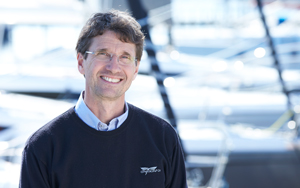
Jens Quorning
CEO and Sole Owner of Quorning Boats

Børge Quorning and his younger brother Bent started building the yard themselves
in August 1967 with the only aim to build trimarans in Northern Europe.
This is still the same building and production hall right next to the main office.
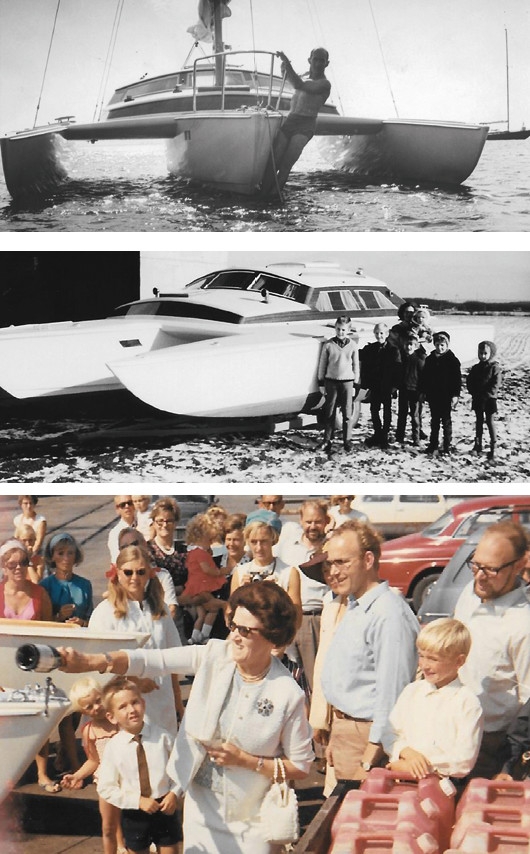
Production of hull No 1 at the yard, the trimaran Trident 28, designed by Børge, who at that time already had designed and built several trimarans in Vancouver in the early and mid-1960’s.
Børges mother Agnes is babtizing hull No 1. Jens is the small boy watching carefully, and, further to the right, Børge, Jens’ brother Eric, and Bent.

Trident 28 hull No 1 was sold, but no more orders came in to this still new and unknown trimaran concept. Therefore, Børge and Bent decided to go safe and designed a traditional double-ended fishing and leisure boat. The Luna 19 series started.
Fiberglass was still a new product for boats.
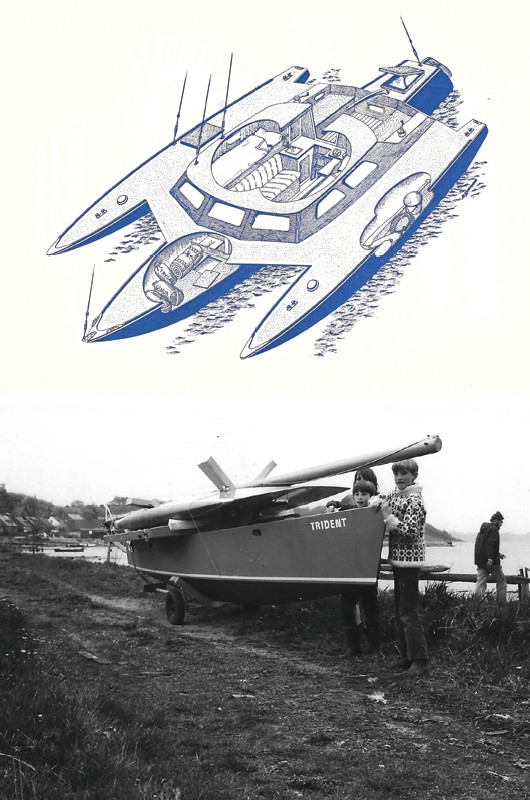
Børge could not forget about the Trimarans, and he and Bent started building several smaller experimental trimarans. The first one was the Trident 22, built in plywood and fiberglass.
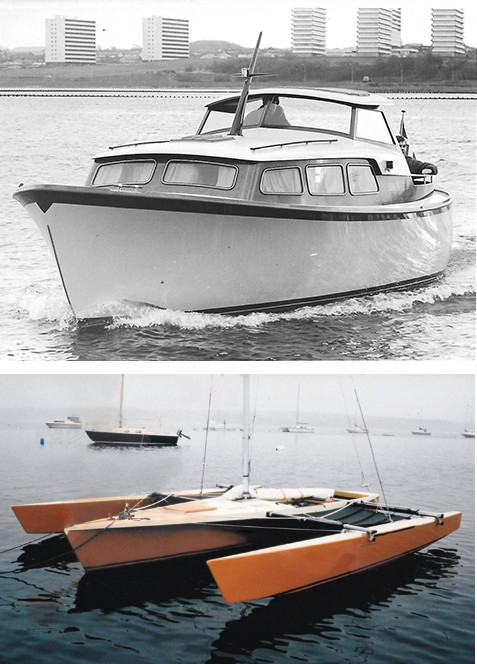
Time was up to grow bigger, and the larger popular double-ended Luna 26 was designed and built and became very popular throughout the 1970’s – later also with a smaller rig, which was quite popular at that time.
Børge and Bent built the next smaller experimental trimaran to learn more, the Trident 19, also built in plywood and fiberglass.
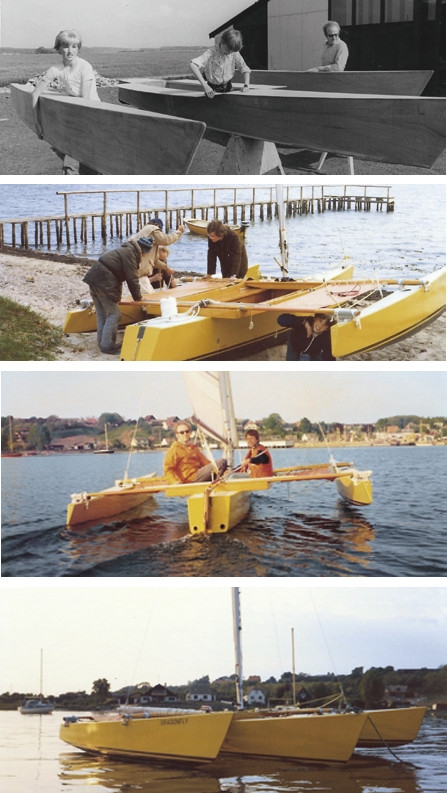
Børge now built a smaller 16´ trimaran for his two small boys, Eric and Jens. No way they should start in the Optimist. This was the very first trimaran to be named “Dragonfly”, and the nickname also became “The Yellow One”, or, in Danish “Den Lille Gule”, also built in plywood and foam. The hulls/crossbeams were tied together with thin line only – no bolts.
The second production hall was built, to get enough space for the Luna boat production. Today, this is the center assembly hall for the DF 25+ DF 32/35 productions.

The smaller Trident 24, was designed and built in plywood/fiberglass, called “Grove Løjer”.

Børge and Bent split up, and Bent started a new and more modern boat yard facility in Middelfart, building the at that time famous “Safir” powerboat range from 24-26-28 feet. Later, Bent played a major roll for the Swedish “Nimbus” powerboat range for development and production.
Børge started the first production trimaran range, the Trident 27 series, that later came in a very different version of beam and rigging construction, built in GRP foam sandwich and balsa core. Production went on up till 1979. Many of these boats were delivered only half completed for partly homebuilding.
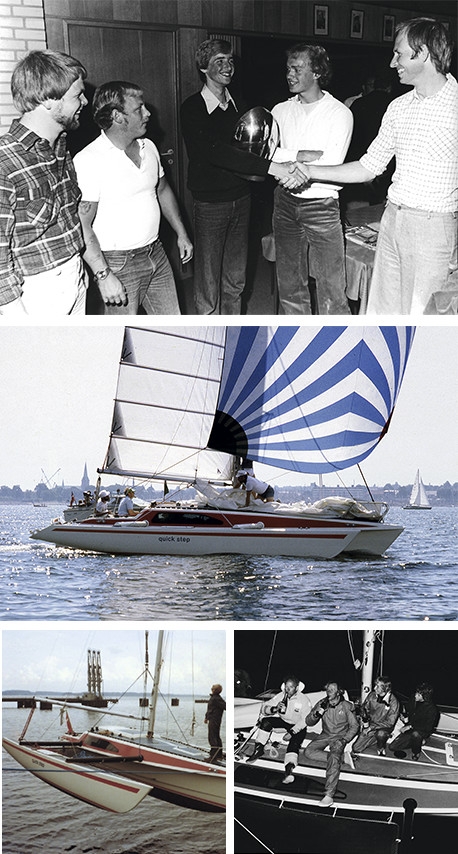
“Quick Step” One Off Trimaran 28´feet was built, based on the center hull from the Trident 27, but longer and with new float design (these floats became the future design up till the mid 1990’s). Quick Step was the first real breakthrough in racing for Børge, as he, along with his two very young boys won the “Round Zealand Race” by first ship home, crewing Gunner Dalgaard as well. Jens and Eric were only 16 and 18 years old. Over 1,500 boats participated in this race in tough conditions.
Jens starts his apprenticeship at the yard.
Later in 1978, Eric was first multihull to set a record in the prestigious record-breaking trophy “The Silver Spinnaker” Round Zealand, where number of hulls and sails was no limit. Among Eric´s crew was also the young Jesper Bank.

The at that time exclusive Luna 31 was launched, a full planing trawler type (22 knots). The energy crises at that time made it difficult to sell in bigger numbers though, and only 11 boats were built till 1981.
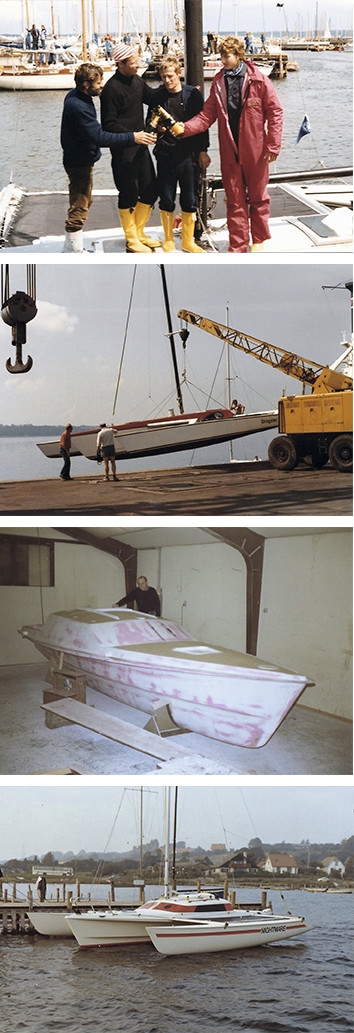
The legendary 35´One Off Trimaran “Dragster”, where the center hull was designed by Børge and built at Quorning Boats by the well-known Gert Frederiksen, who won the “Little America´s Cup” trophy back in 1969. Gert and Jens built the boat. This project made Gert start his worldwide known blocks and traveler series “Frederiksen” in Vejle, now bought by Ronstan. Dragster won Round Zealand many times and won the “Silver Spinnaker” with Jens as crew.
The original and first production trimaran named “Dragonfly” was the Dragonfly 25, designed and built by Børge and Jens, as the yard at this point had basically no orders and all employees had to go – it was very difficult times for Quorning Boats. But, this also started a new era for the company, where focus basically was on the trimarans only, and soon thereafter only on trimarans.
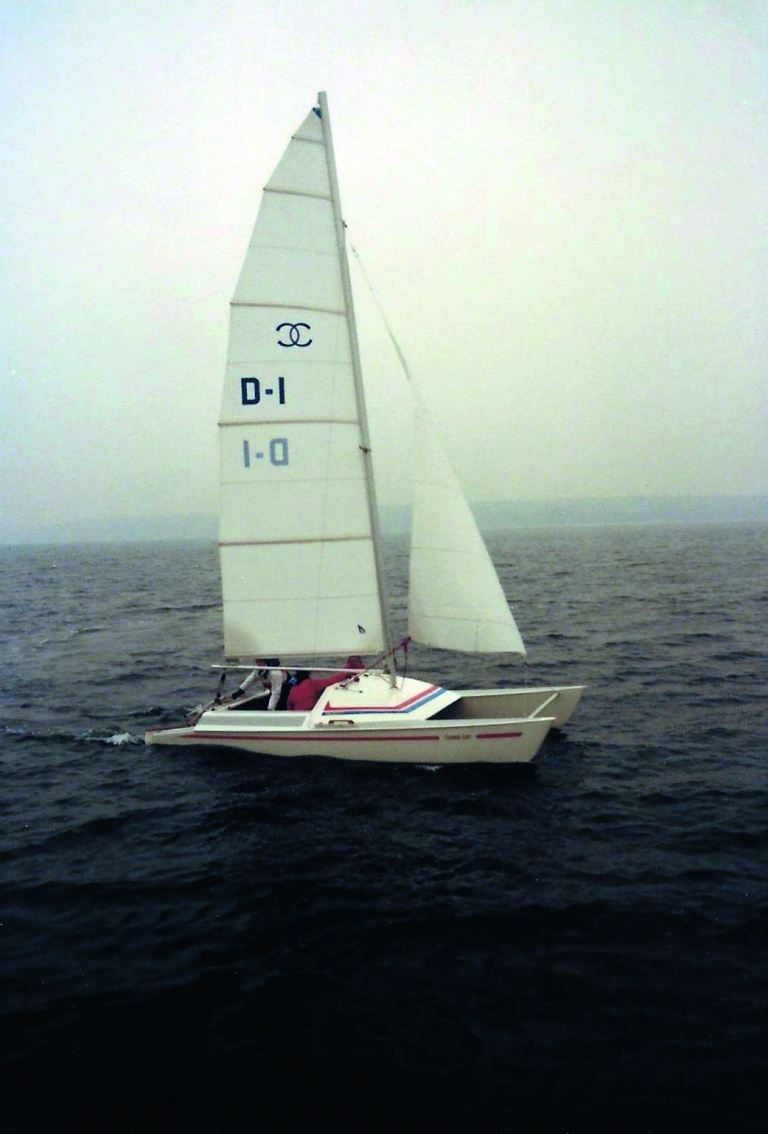
To test new markets, the one and only catamaran built at the yard, the “Combi Cat” was built for a German client, based on the floats from the Dragonfly 25.

Børge designed a new 35´One Off Racing Trimaran for Jens, and Børge helped Jens building this special plywood trimaran “Quick Step II”. The goal was to win back the Round Zealand trophy “The Silver Spinnaker”, and the year after Jens, crewing his brother Eric, Erik Fruergaard and Hans Henrik Albrechtsen sat a record of only 19 hours and 27 min. for the 235 NM race. This record stood for 25 years. Quick Step was even using foils on the floats, reaching top speed of 28 knots in 1983.

Jens and Eric entered the famous 2-handed “Round Britain & Ireland Race” in each their trimaran. Eric in his own built and modified Dragonfly 25 “Magic Hempel”, the smallest boat in the total fleet, crewing Erik Fruergaard. Jens in his new rebuilt “Quick Step III”, now with a big new rotating wing section mast and extreme beam of 31 feet, crewing Bo Rasmussen. On the Boxhaul Trophy handicap, Eric won overall, and Jens was second in this extreme tough 2,000 NM race. This was for sure the international breakthrough for Dragonfly and the Quorning family.
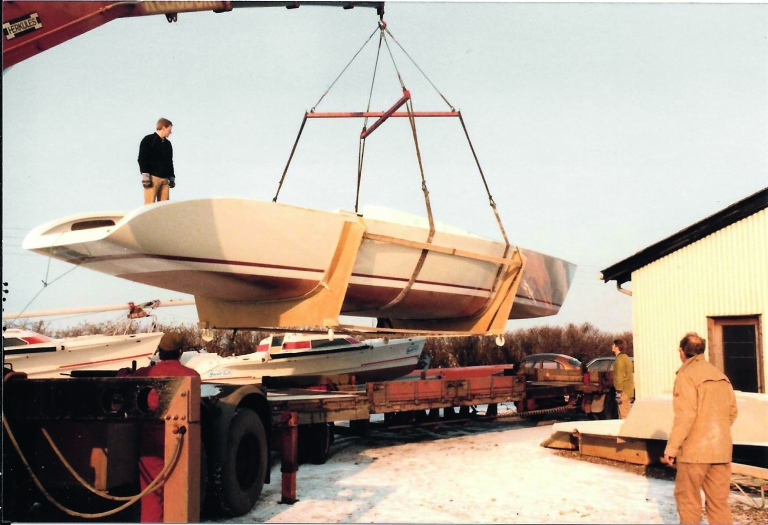
The Dragonfly 25 molds and tooling was sold to Canada – for the Dragonfly to be built on royalty basis for the North American market. However, the project was not a success. “Vitesse 52”, the one and only monohull yacht ever built at the yard, was at that time the biggest Danish yacht built in epoxy.
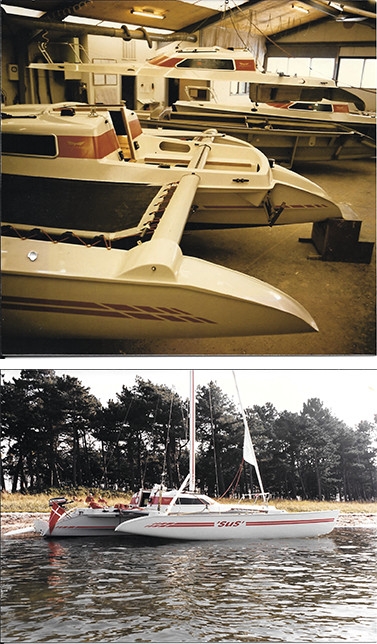
The new Dragonfly 800 came to life, still trailerable, more room inside, and now with centerboard.
Eric, Jens, crewing Peter Vedel won and were “First ship Home” in the famous “Färder Race” in Oslo in a standard Dragonfly 800.

Eric and Jens sat new record in the prestigious 645 NM “Round Denmark” race in a standard Dragonfly 800 MKII along with the third crew member, Bo Rasmussen. Back then, this race was open for all hull designs and sizes.
Jens and Henrik Bøje won the European Championship in the Multihull Micro Class up till 26 feet, sailing the Dragonfly 800 MKII in Holland.
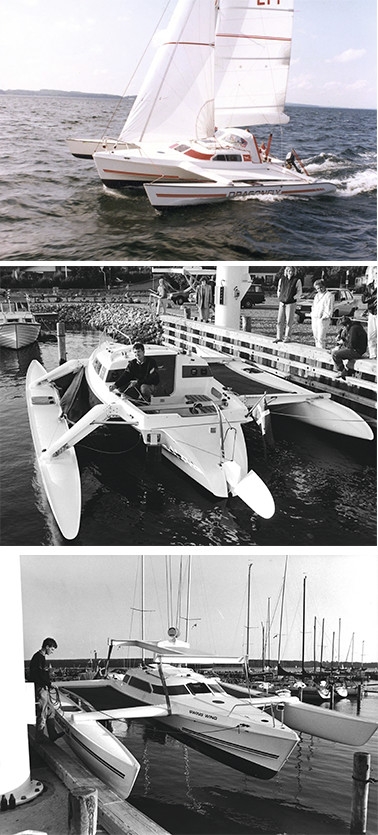
The new updated Dragonfly 800 MKIII was introduced. It was basically the same boat, but now with GRP composite wings, still not foldable though. 6 boats built.
The very first foldable Dragonfly ever, was the Dragonfly 800 Swing Wing, which was launched in August – most likely the biggest step in the Dragonfly history and Quorning Boats design after years of development. The system worked, and the yard expected to have two production lines still – folding and non-folding, as it was very uncertain, how the market would accept this new strange folding product. The Swing Wing system took off.

Paul Elvström got his own private Dragonfly 800 Swing Wing, but with 1.4 m taller rigging. Paul sailed this boat for 10 years, till he stopped his sailing career. This also became an experimental boat, where Paul gave many inputs to construction and design.
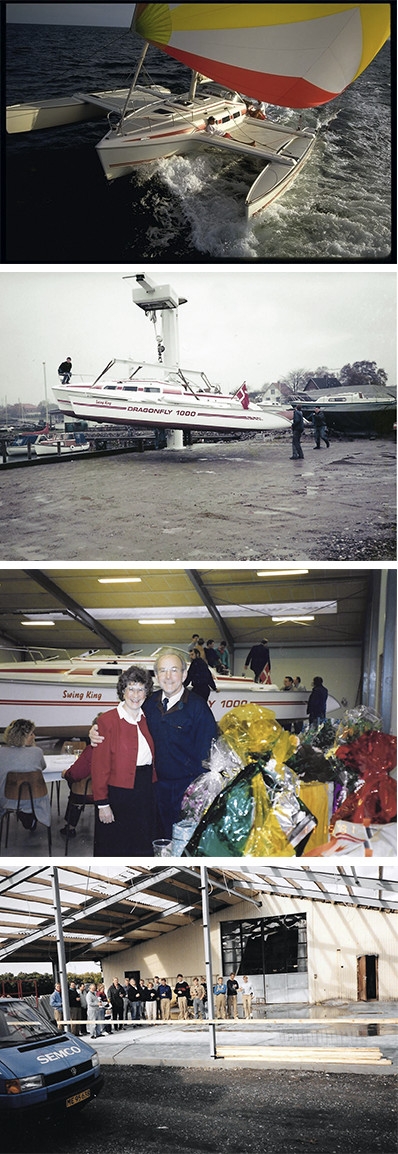
Dragonfly 600 was born, a smaller open trailerable day sailor more for fun. 11 boats built.
The third extension production building was made – today this building is dedicated for the Dragonfly 28 assembly.
Dragonfly 1000 Swing Wing was introduced to the market in late 1991. This was a big step for the yard to enter the market with a bigger and more cruising type boat, with inboard engine but still fast in those years. 42 boats built till 2002.

Jens and Henrik Bøje won the European Championship in the Micro Multihull Class in Holland onboard the Dragonfly 800 Swing Wing.

Jens took over the company after his parents Børge and Bit. Jens´s wife Lene started to take over the bookkeeping from Bit. The yard now got a serious makeover, with a new office building and 2 new production halls, including better and modern ventilation systems.
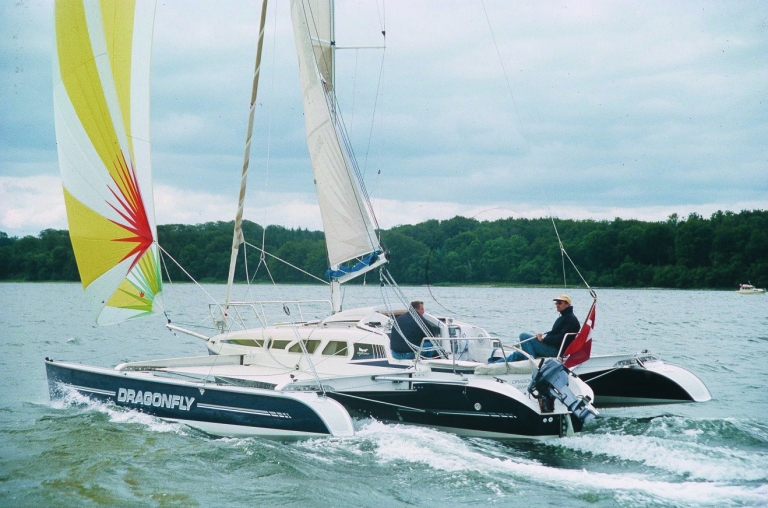
The Dragonfly 920 Cruising was introduced to the market at the “BOOT Düsseldorf” and became one of the very big successes for the yard. 168 boats built till 2008. The Dragonfly 920 was still trailerable, but had to be taken apart for transport. This boat was one of the early and first production boats to introduce Carbon mast as standard.
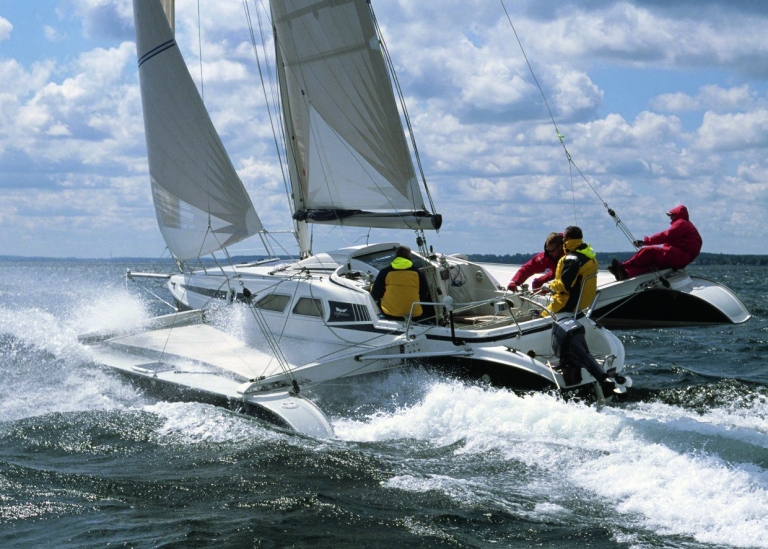
The GRP lamination section burned down to the ground, and the fire also had influence on many other sections of the yard. Consequently, the production was set back for quite some time, and many important moulds were lost in the flames. It was a big challenge to move on from here.
The Dragonfly 920 Racing came on the market. Same boat, but with 45 cm longer mainsail boom to give more power.
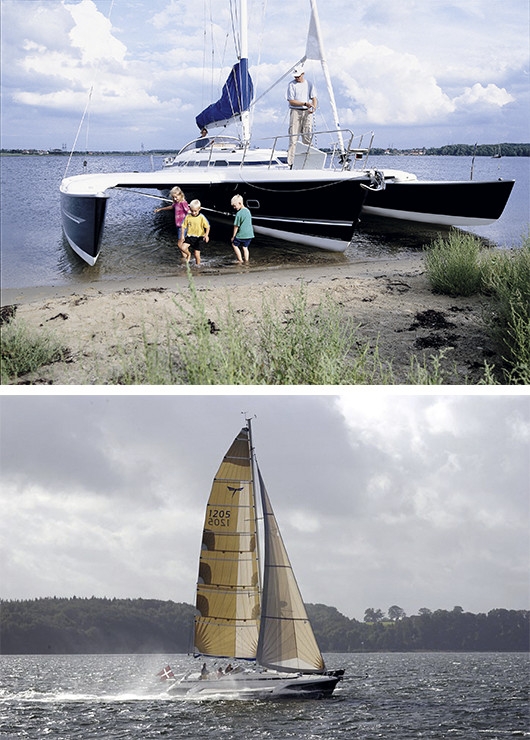
The new millennium came – and Quorning Boats was very proud to present their new Flagship, Dragonfly 1200 Ocean Cruiser (Swing Wing), a great and fantastic 40´ folding trimaran, with a separate aft cabin and various engine sizes for speed under power up to 16 knots. 18 boats built up till year 2007, almost half went to the US market.
Børge stopped officially at the yard, but he still has his own little workshop for his own experimental projects.

Børge and Jens received the very famous and prestigious prize, “The Danish Design Award” handed over by his Royal Highness, the Crown Prince of Denmark, for the Dragonfly 1200 design. This prize highly ranked in the Danish design industry, and is probably the most prestigious prize Quorning Boats has ever received, among many great prizes over the years.
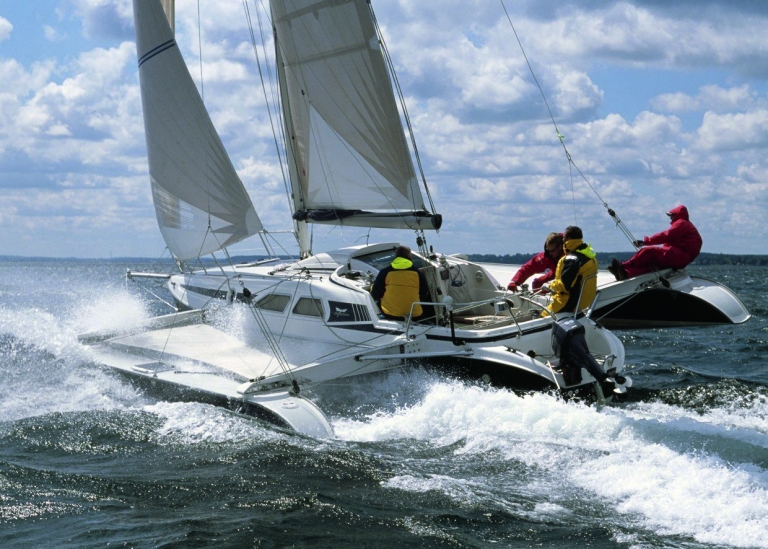
Dragonfly 920 Extreme was introduced, with 1.2 m more beam and 1.5 m taller Carbon mast, a much more powerful boat with fantastic upwind performance. This new Extreme version boosted the sale up till 2008.
Dragonfly 920 Extreme won the overall prize for the “European Yacht of the Year” in the category for all yachts up to 30 feet. This came quite unexpected and was a great acceptance for production trimarans.

The Dragonfly 35 hull No 1 was launched, a very complex boat to build featuring great new ideas, like the kayak in the float and the cockpit rail to fold up to cockpit tent rail. Already before the launch, the boat was a great success, as 17 boats were sold before hull No 1 was even launched. The boat is still active in production, as it was ahead of its time by its introduction. This boat comes in the Touring and the Ultimate version, which has a 2-meter taller mast.
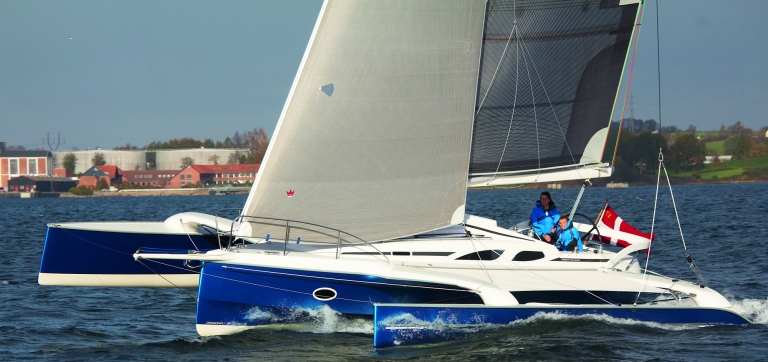
The Dragonfly 35 won the title “European Yacht of the Year”.
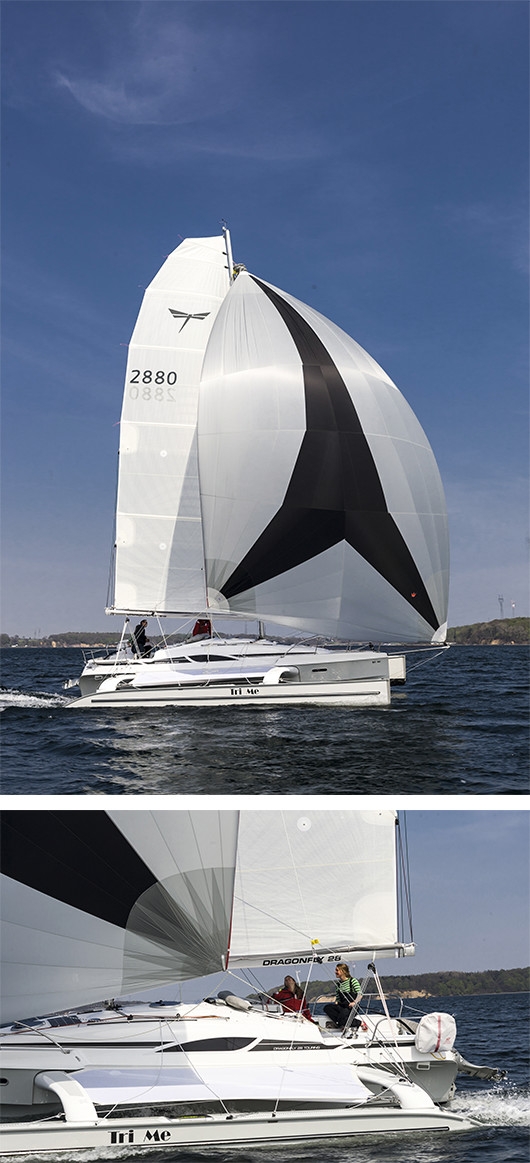
The new Dragonfly 28 replaced the older design of the Dragonfly 920. The new Dragonfly 28 was the first Dragonfly to just fold and trailer without taking anything apart, except lowering the mast. The Dragonfly 28 came in a Touring and Sport version. The timing was great for the coming financial crises, where this smaller boat took Quorning Boats through tough financial times.
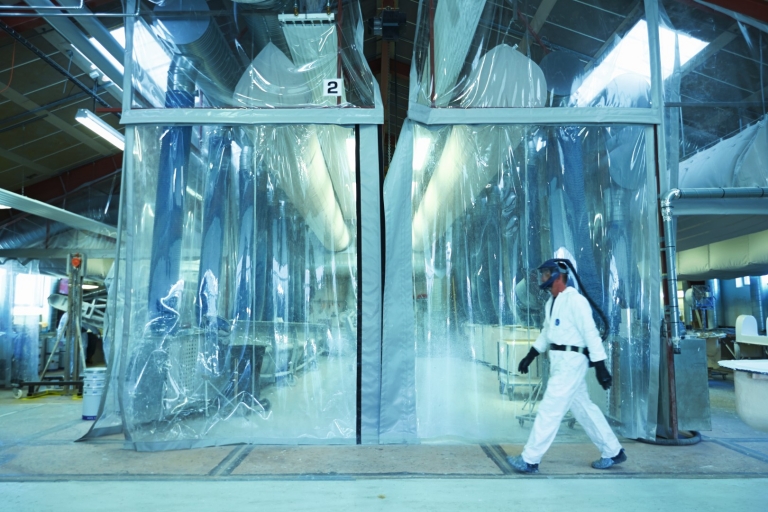
Quorning Boats bought the lamination shop from the neighbor Faurby. This facility got 100% renovated with a top modern ventilation system.
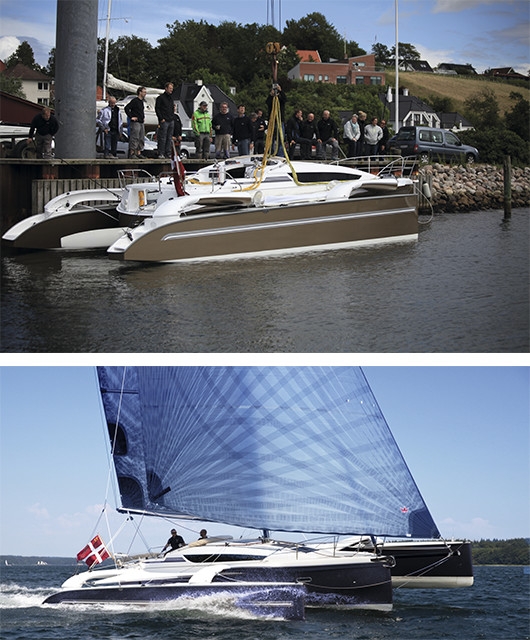
The Dragonfly 32 came on the market, as a smaller version of the Dragonfly 35 to meet the market with a less expensive boat. The Dragonfly 32 comes in a Touring and a Supreme version with a 2 m taller mast. This boat was designed for both in- and outboard engines.
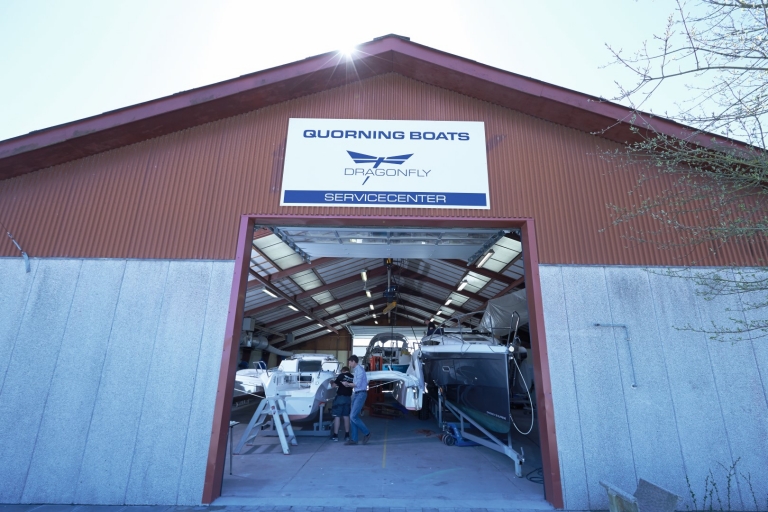
Quorning Boats bought the neighbor Faurby production facility, which today still houses the new Dragonfly Service Center.
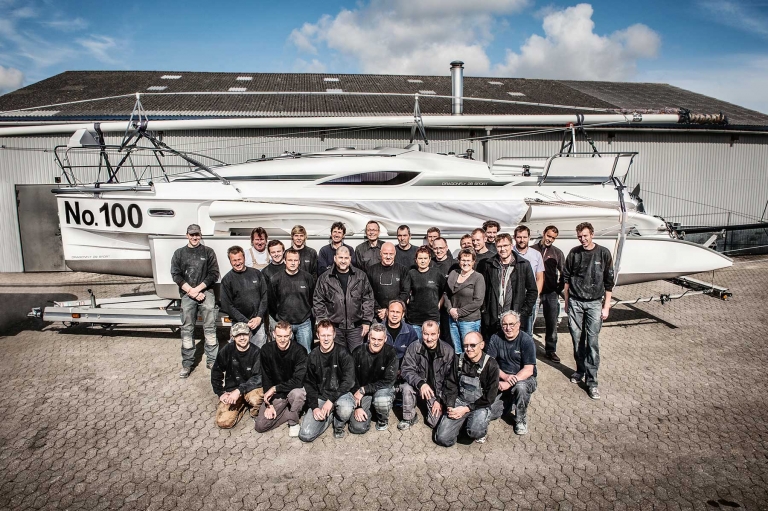
Celebrating Dragonfly 28, hull No 100 - a milestone in the Dragonfly 28 production.
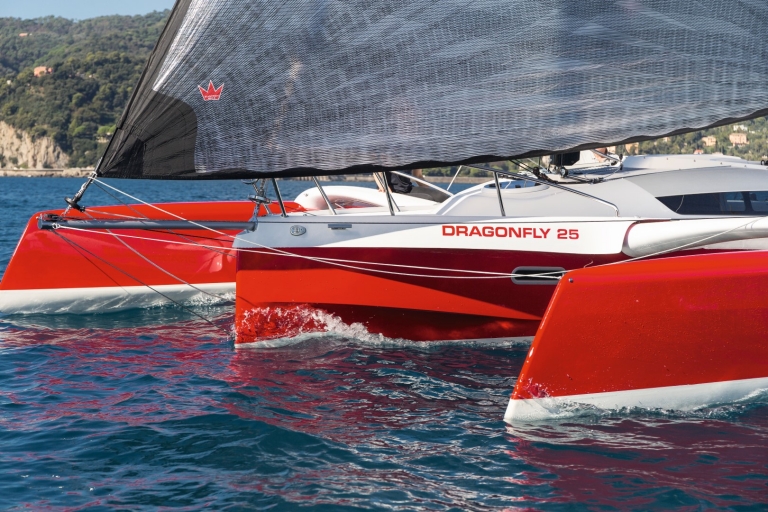
The new Dragonfly 25 was introduced on the market, to get younger clients sailing these great boats. A Touring version with 10.5m Alloy mast, and the Sport version with a 11.8 m rotating Carbon mast.

Dragonfly 28 Performance is launched with new bigger wave piercing floats for more stability and faster sailing in stronger wind conditions.
Dragonfly 25 wins the title ”European Yacht of the Year”. 3rd time Quorning Boats wins this prestigious title. Only few yards have achieved this. New production record of 52 new boats built in one year.

Celebrating 50 Years of Dragonfly.
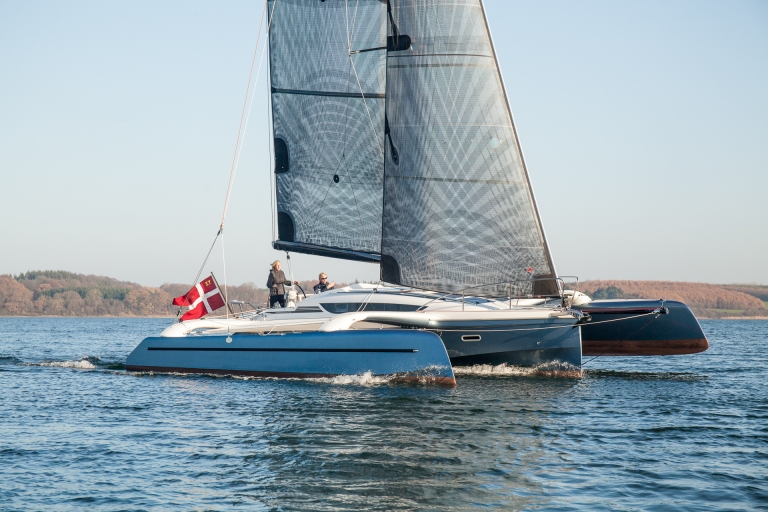
Dragonfly 32 Evolution is launched with the design of the new generation wave piercing floats. Dragonfly 32 Evolution replaces the Dragonfly 32 Supreme.
Dragonfly 32 Evolution is nominated Multihull of the Year 2019 in the "Until 40 feet"-category.
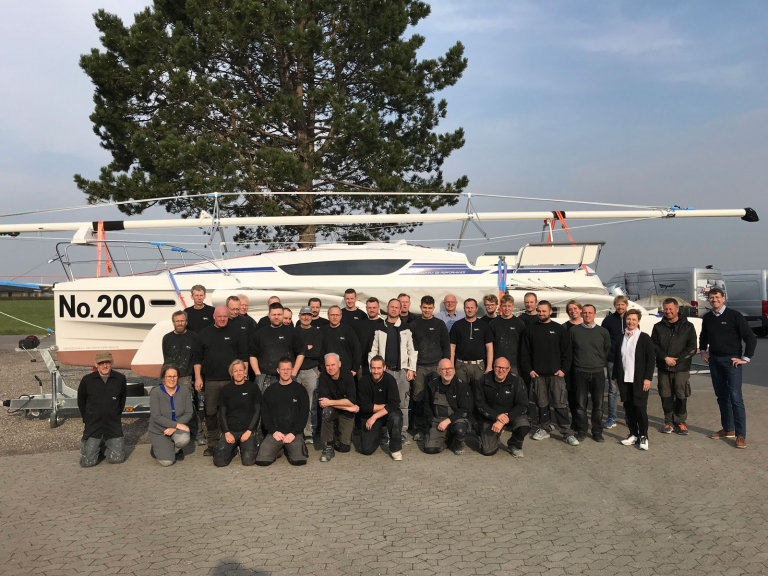
Yet another milestone in the Dragonfly 28 production - Dragonfly 28, hull No 200.
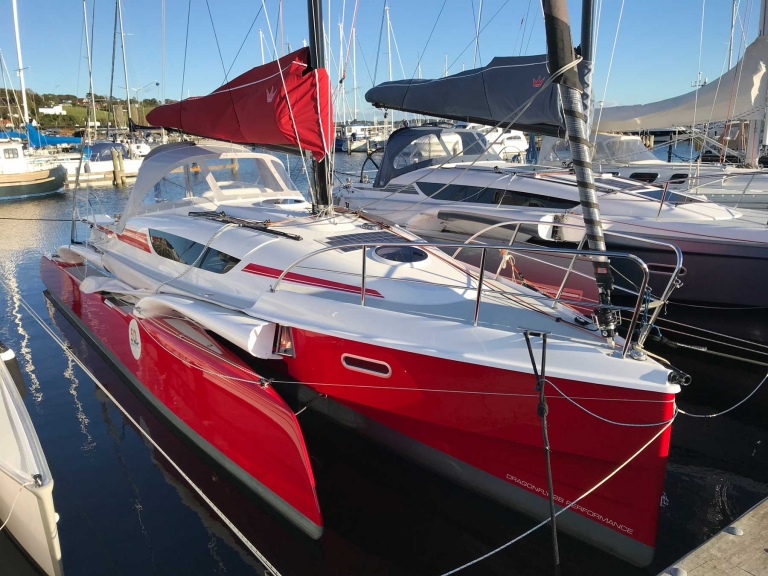
Celebrating 30 Years of the Dragonfly Swing Wing system, which was designed by Børge and Jens Quorning back in 1989. Using this revolutionary system, the trimaran can be folded reducing the beam by more than 50% in less than one minute per side, using no tools and operating only from the cockpit.

World Premiere of the new Dragonfly 40 Performance Cruiser at BOOT 2020 in Düsseldorf, Germany.
After more than two years of development, thousands of man hours and big investments, we could finally welcome the newest member to the Dragonfly family.
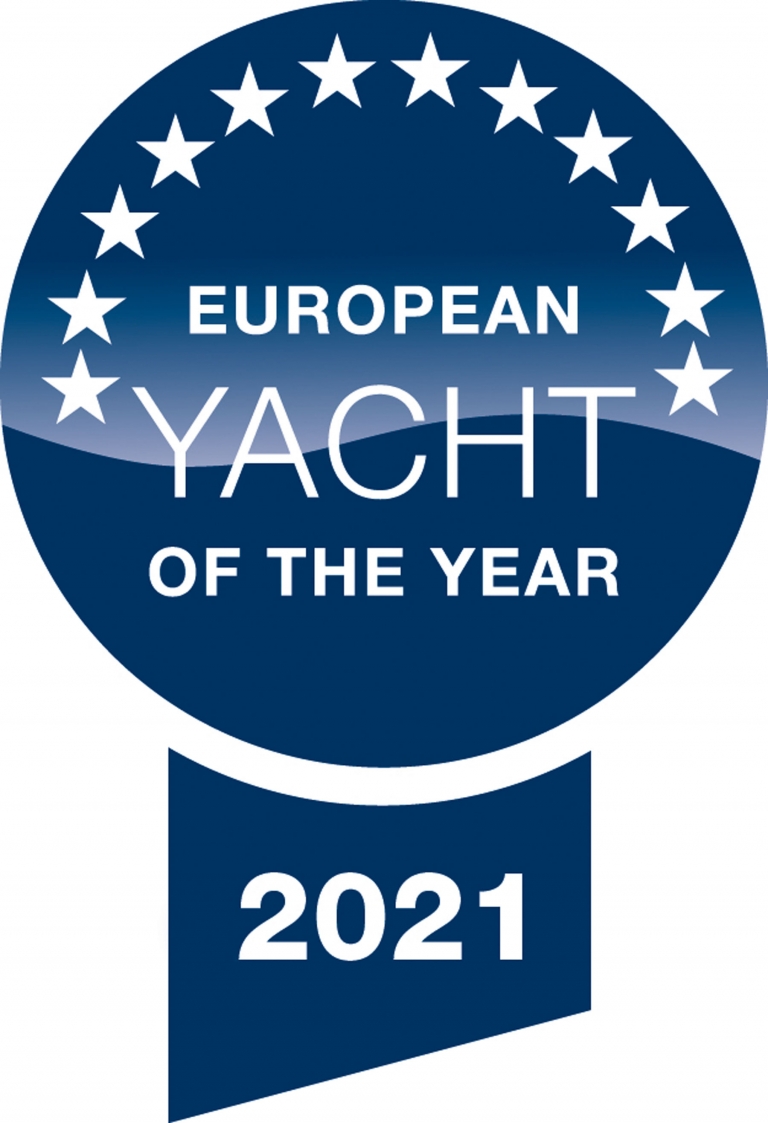
The Dragonfly 40 won the “European Yacht of the Year 2021”, in the Performance Cruiser Category. This is Quorning Boats’ 4th EYOTY title.
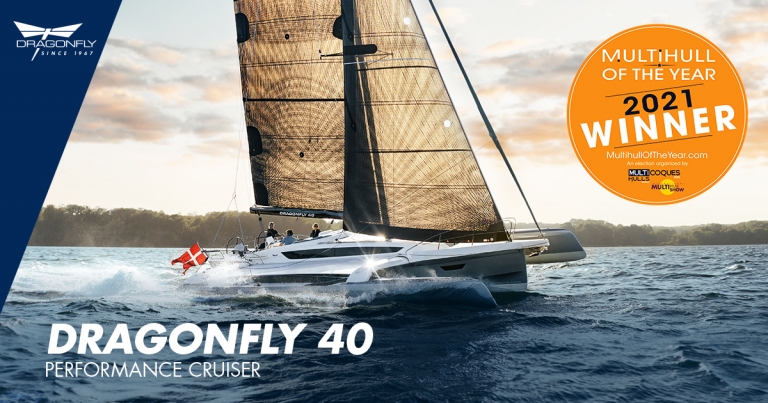
The Dragonfly 40 won the title as “Multihull of the Year 2021”, by Multihull Magazine, in the under-45-feet category.
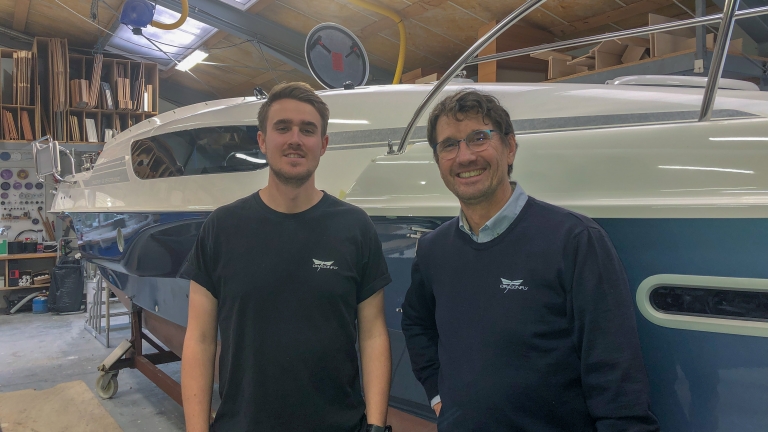
Peter Quorning started his apprenticeship at Quorning Boats in August 2021 and is the third generation to take over the company.
1966 Børge Quorning returned to Denmark after having worked as a boat builder in Canada. He was fuelled by the ambition to build trimarans and make Europeans appreciate them. Together with his younger brother, Bent Quorning, he bought a piece of land in Skærbæk and set to work on building a yard in 1967.
1968 the first boat was built at the yard, the Trident 28'.
Between 1969 - 1973 various trimaran prototypes (16' - 24') were built.
1974 the first production trimaran was built at Quorning Boats. It was the Trident 27’, and it would come in various designs up until 1979 by which time the company had built 36 boats. Trident 27’ was the realisation of the vision that Børge had from the beginning, and so it is an important boat in the history of the company. It was the first major step towards the range of boats on offer today, and this boat would quickly earn Quorning Boats widespread respect.
1980 was the year when Dragonfly 25’ (MK I) was put into production. This is a very important landmark in the company’s history because it marks the beginning of Quorning Boats’ successful range of production trimarans under the now well-known name of Dragonfly. Between 1980 and 1986, the company built 50 Dragonfly 25’.
From 1987 to 1988 the yard produced 58 boats of the type Dragonfly 800 (MK II), and in 1989 six boats of the type Dragonfly 800 (MK III). These two versions of the Dragonfly 800 were not folding, and it suddenly became difficult to sell this type, as Quorning Boats introduced the new Swing Wing system in 1989. This invention gave the Dragonfly greater versatility and thereby made it more attractive. Provided with the this new Swing Wing system, the boat took up much less space when in port, and it was a lot easier to transport it on a trailer. From 1989 and well into the new millennium (2005), the company built 143 Dragonfly 800 Swing Wing.
From 1991 to 1993, Quorning Boats produced 11 of the smaller open Dragonfly 600 Daysailor, not folding. It was primarily the brainchild of Børge, who always took a special liking to the smaller boats.
Dragonfly 1000 Swing Wing went into production in 1991, and when it went out of production again in 2002, the company had built 41 boats. It was awarded "Boat of the Year" in USA in 1994, and the jury praised the boat for its construction. Reviews underlined the high performance and comfortable interior of this boat.
Jens Quorning started his apprenticeship at Quorning Boats with his farther Børge back in 1978. This was a natural step, as Jens had spent most of his life with his father at the yard, since the yard was founded. Jens Quorning became financially involved in the company in 1991, and by 1995 he was the sole owner of the company.
In 1996 the new Dragonfly 920 Swing Wing, which was released in two different versions: Cruising and Racing. This boat was larger than the Dragonfly 800, and came with a carbon mast as standard. The Dragonfly 920 was made to fill the gap between Dragonfly 800 and Dragonfly 1000, and the goal was to combine the sailing qualities of the Dragonfly 800 with spaciousness and standing height.
The new millennium gave introduction to a rather special boat at Quorning Boats. The Dragonfly 1200 Swing Wing is the largest boat ever in production at the yard.18 Dragonfly 1200 were built between the years 2000 and 2007, each boat built to the special ideas and demands of the owner. It as an Ocean Cruiser and the flagship of the company. Quorning Boats received the "Danish Design Prize" for the Dragonfly 1200 in 2001.
In 2003 the company came up with the Extreme version of the Dragonfly 920 Swing Wing. As the boat went out of production in 2008, 165 boats had been built in the three versions: Cruising, Racing or Extreme.
In 2006 Quorning Boats finished the first of the Dragonfly 35 Swing Wing, an Offshore and Ocean Cruiser made in the Touring or Ultimate version. This particular boat represents a new method of boat building. The company left the old method involving marking gauges, drawing paper, parchment, markers, a calculator etc. Now the technological era of boat building began. Jens’ good friend and colleague, Naval Architect Steen Olsen, plays an important role from now on as regards designing new boats. Today objects are made using a 5-axis CNC milling cutter. The process requires a floppy disk with the design, a large block of polystyrene and the cutter itself. The first Dragonfly 35 was launched after 3 years' development.
Right before the financial crisis of 2008, Jens received a tip-off from an English customer working in finance. This made him choose to produce the Dragonfly 28 Swing Wing instead of larger boats, and in retrospect this boat got Quorning Boats through the crisis. Production began in 2009. It is by far the most complicated boat Quorning Boats has ever produced with regard to the technics of production. It was a challenge to make the boat fit the 2.55m trailer width maximum, but this feature of course added enormously to the overall attraction of the boat. It comes in a Touring and a Sport version. It was nominated for "European Yacht of The Year" in 2010.
The Dragonfly 32 was introduced in 2012. This boat is designed by Jens Quorning and Steen Olsen and is intended for cruising as well as fast racing, being the fastest trimaran currently on offer from Quorning Boats. The Dragonfly 32 fills in the gap between the Dragonfly 28 and the Dragonfly 35. The Dragonfly 32 appears in two versions: Touring and Supreme. The Dragonfly 32 was nominated "European Yacht of the Year 2013" and awarded "Performance Boat over 30 ft. 2013" by Yachts & Yachting. Further, the Dragonfly 32 was awarded by SAIL Magazine in the category "Best Multihull 31'-40'" in 2014.
The newest boat to enter production is the Dragonfly 25, which was introduced January 2015. The Dragonfly 25 is a trailer-sailer and available in two versions, a Touring version and the more powerful and dynamic Sport version. The Dragonfly 25 is awarded by SAIL Magazine as "Best Boat 2015" in the category "Small Cruiser". Further, the Dragonfly 25 won the "European Boat of the Year 2015" award in the multihull category. The Dragonfly 25 was up against larger cruising catamarans, and it was the only trimaran represented in the multihull category.
In 2018 Quorning Boats introduced the Dragonfly 32 Evolution with the design of the new generation wave piercing floats. Dragonfly 32 Evolution replaces the Dragonfly 32 Supreme, whereas the Dragonfly 32 Touring remains the same. Dragonfly 32 Evolution is nominated Multihull of the Year 2019 in the "Until 40 feet"-category.